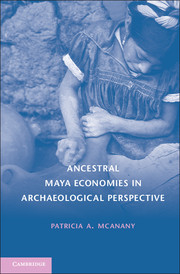Book contents
- Frontmatter
- Dedication
- Contents
- List of Figures
- Preface and Acknowledgments
- 1 The Materiality of Practice in Ancestral Maya Economies
- 2 Situating Maya Societies in Space and Time
- 3 Feeding a Hungry Landscape
- 4 Gendered Labor and Socially Constructed Space
- 5 Ritual Works: Monumental Architecture and Generative Schemes of Power
- 6 Naturalized Authority of the Royal Court
- 7 Social Identity and the Daily Practice of Artisan Production
- 8 Places, Practices, and People of Commerce
- 9 Flowery Speech of Maya Tributary Arrangements
- 10 Skeining the Threads
- References Cited
- Index
7 - Social Identity and the Daily Practice of Artisan Production
Published online by Cambridge University Press: 05 December 2014
- Frontmatter
- Dedication
- Contents
- List of Figures
- Preface and Acknowledgments
- 1 The Materiality of Practice in Ancestral Maya Economies
- 2 Situating Maya Societies in Space and Time
- 3 Feeding a Hungry Landscape
- 4 Gendered Labor and Socially Constructed Space
- 5 Ritual Works: Monumental Architecture and Generative Schemes of Power
- 6 Naturalized Authority of the Royal Court
- 7 Social Identity and the Daily Practice of Artisan Production
- 8 Places, Practices, and People of Commerce
- 9 Flowery Speech of Maya Tributary Arrangements
- 10 Skeining the Threads
- References Cited
- Index
Summary
Truly now,
Double thanks, triple thanks,
That we've been formed, we've been given
Our mouths, our faces,
We speak, we listen,
We wonder, we move,
Our knowledge is good, we've understood
What is far and near,
And we've seen what is great and small
Under the sky, on the earth.
Thanks to you we've been formed,
We've come to be made and modeled,
Our grandmother, our grandfather.
On the making of the first humans
by the Maker, the Modeler, from
The Popol Vuh; D. Tedlock 1985:147
trans.; see also Christenson
2007:199 trans.
And so it started – according to the K'iche' Maya book of genesis – when the Maker, the Modeler, first formed humans and gave the species the ability to speak, to know, to see, and to give reverence to their Maker. This generative action of making and modeling would be recapitulated by Maya descendants of the first Grandmother and first Grandfather every time a potter crafted a water jar, a weaver finished a huipil, and a stone worker polished a jadeite earflare. Crafting objects – a quintessential human activity – is an intimate and creative process regardless of whether the object is crafted according to ancestral or cutting-edge techniques. Notions of personal identity, gender roles, and position within society are profoundly entangled with crafted objects that provide a mirror, a materialization, of complex situational and relational forces that underwrite the very process of fabrication.
- Type
- Chapter
- Information
- Ancestral Maya Economies in Archaeological Perspective , pp. 199 - 252Publisher: Cambridge University PressPrint publication year: 2010

